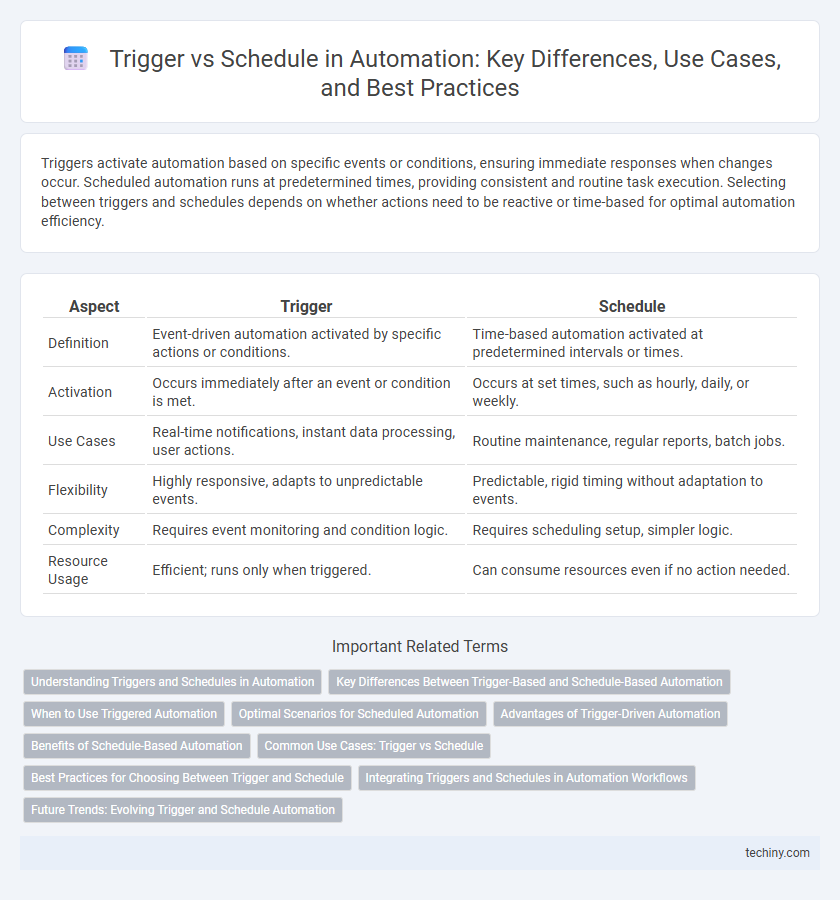Triggers activate automation based on specific events or conditions, ensuring immediate responses when changes occur. Scheduled automation runs at predetermined times, providing consistent and routine task execution. Selecting between triggers and schedules depends on whether actions need to be reactive or time-based for optimal automation efficiency.
Table of Comparison
| Aspect | Trigger | Schedule |
|---|---|---|
| Definition | Event-driven automation activated by specific actions or conditions. | Time-based automation activated at predetermined intervals or times. |
| Activation | Occurs immediately after an event or condition is met. | Occurs at set times, such as hourly, daily, or weekly. |
| Use Cases | Real-time notifications, instant data processing, user actions. | Routine maintenance, regular reports, batch jobs. |
| Flexibility | Highly responsive, adapts to unpredictable events. | Predictable, rigid timing without adaptation to events. |
| Complexity | Requires event monitoring and condition logic. | Requires scheduling setup, simpler logic. |
| Resource Usage | Efficient; runs only when triggered. | Can consume resources even if no action needed. |
Understanding Triggers and Schedules in Automation
Triggers initiate automation workflows based on specific events or changes in conditions, enabling real-time responses to data or user actions. Schedules execute automation tasks at predefined intervals or times, optimizing repetitive processes without manual intervention. Understanding the distinction between event-driven triggers and time-based schedules enhances efficient automation design and resource allocation.
Key Differences Between Trigger-Based and Schedule-Based Automation
Trigger-based automation activates workflows instantly in response to specific events such as user actions, data changes, or system alerts, ensuring real-time responsiveness and efficiency. Schedule-based automation runs at predetermined times or intervals, offering predictable, routine task execution without dependency on external events. Key differences include the immediacy of trigger-based systems versus the regularity and planning advantage of schedule-based systems, impacting resource allocation and operational agility.
When to Use Triggered Automation
Triggered automation is ideal for real-time responses based on specific user actions or events, such as form submissions, clicks, or changes in data. This approach ensures immediate execution of workflows, enhancing customer experience and operational efficiency by addressing individual behaviors promptly. Employ triggered automation when personalized, context-driven interactions or instant updates are essential to your process.
Optimal Scenarios for Scheduled Automation
Scheduled automation is ideal for repetitive tasks that require execution at consistent intervals, such as daily data backups or monthly report generation. It optimizes resource allocation by automating processes during off-peak hours, reducing system load and preventing bottlenecks. This approach enhances reliability and predictability, ensuring critical operations run without manual intervention.
Advantages of Trigger-Driven Automation
Trigger-driven automation offers unparalleled responsiveness by initiating workflows based on specific real-time events or conditions, ensuring immediate action without delays. This approach minimizes resource wastage by activating processes only when necessary, leading to improved operational efficiency and reduced costs. Enhanced precision in task execution results from event-based triggers, which align automation closely with dynamic business needs and user behaviors.
Benefits of Schedule-Based Automation
Schedule-based automation ensures tasks are executed consistently at predetermined times, enhancing operational reliability and efficiency. It reduces the risk of human error by automating repetitive processes such as system backups, report generation, and software updates. Predictable scheduling allows resource optimization and easier compliance with maintenance windows or regulatory requirements.
Common Use Cases: Trigger vs Schedule
Trigger automation initiates workflows based on specific events such as form submissions, user actions, or system alerts, enabling real-time responses and immediate task execution. Scheduled automation runs tasks at predefined intervals or times, ideal for routine maintenance, report generation, and batch processing. Combining triggers with schedules optimizes operational efficiency by balancing event-driven actions with consistent, time-based processes.
Best Practices for Choosing Between Trigger and Schedule
Choosing between trigger-based and schedule-based automation depends on the specific workflow requirements and desired responsiveness. Trigger automation excels in real-time reaction to events, such as instant notifications upon data changes or user actions, enhancing efficiency and reducing latency. Scheduled automation suits regular, predictable tasks like daily report generation or system maintenance, ensuring consistent execution without manual intervention.
Integrating Triggers and Schedules in Automation Workflows
Integrating triggers and schedules in automation workflows enhances operational efficiency by enabling dynamic task execution based on real-time events and predefined timeframes. Triggers activate workflows instantly upon specific conditions, such as incoming data or user actions, while schedules ensure recurring processes run at designated intervals. Combining both mechanisms allows businesses to optimize resource allocation and maintain continuous, responsive automation systems.
Future Trends: Evolving Trigger and Schedule Automation
Future trends in automation emphasize the integration of AI-driven triggers that adapt in real-time based on user behavior and environmental data, surpassing traditional fixed schedules. Scheduled automation is evolving to incorporate predictive analytics, enabling systems to anticipate needs and execute tasks proactively rather than reactively. This shift enhances operational efficiency by blending dynamic triggers with intelligent scheduling frameworks, setting new standards for responsive and adaptive automation systems.
Trigger vs Schedule Infographic

 techiny.com
techiny.com